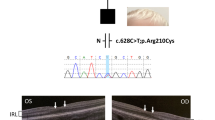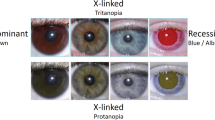Abstract
Although eye color is usually modeled as a simple, Mendelian trait, further research and observation has indicated that eye color does not follow the classical paths of inheritance. Eye color phenotypes demonstrate both epistasis and incomplete dominance. Although there are about 16 different genes responsible for eye color, it is mostly attributed to two adjacent genes on chromosome 15, hect domain and RCC1-like domain-containing protein 2 (HERC2) and ocular albinism (that is, oculocutaneous albinism II (OCA2)). An intron in HERC2 contains the promoter region for OCA2, affecting its expression. Therefore, single-nucleotide polymorphisms in either of these two genes have a large role in the eye color of an individual. Furthermore, with all genetic expression, aberration also occurs. Some individuals may express two phenotypes—one in each eye—or a complete lack of pigmentation, ocular albinism. In addition, the evolutionary and population roles of the different expressions are significant.
Similar content being viewed by others
Log in or create a free account to read this content
Gain free access to this article, as well as selected content from this journal and more on nature.com
or
References
Hurst, C. C. On the inheritance of eye colour in man. Molecular and General Genet. MGG 1, 393–394 (1908).
Redei, G. Encyclopedia of Genetics, Genomics, Proteomics, and Informatics, 3rd edn (Springer, New York City, NY, 2008).
Sturm, R. & Frudakis, T. Eye Colour: portals into pigmentation genes and ancestry. trends Genet. 20, 327–332 (2004).
Branicki, W., Brudnik, U. & WojasPelc, A. Interactions between HERC2, OCA2, and MC1R may influence human pigmentation phenotype. Annals of Hum Genet 73, 160–170 (2009).
Frudakis, T., Thomas, M., Gaskin, Z., Venkateswarlu, K., Chandra, K. S., Ginjupalli, S. et al. Sequences associated with human iris pigmentation. Genetics 165, 2071–2083 (2003).
Duffy, D. L., Montgomery, G. W., Chen, W., Zhao, Z., Le, L., James, M. R. et al. A three-single-nucleotide polymorphism haplotype in intron 1 of OCA2 explains most human eye-color variation. Am J Hum Genet 80, 241–252 (2007).
Sulem, P., Gudbjartsson, D., Stacey, S., Helgason, A., Rafnar, T., Magnusson, K. P. et al. Genetic determinants of hair, eye and skin pigmentation in Europeans. Nat Genet. 39, 1443–1452 (2007).
Zhu, G., Evans, D., Duffy, D., Montgomery, G., Medland, S., Gillespie, N. A. et al. A genome scan for eye color in 502 twin families: most variation is due to a QTL on chromosome 15q. Twin Res 7, 197–210 (2004).
Eiberg, H., Troelsen, J., Nielsen, M., Mikkelsen, A., Mengel-From, J., Kjaer, K. et al. Blue eye color in humans may be caused by a perfectly associated founder mutation in a regulatory element located within the HERC2 gene inhibiting OCA2 expression. Hum Genet 123, 177–187 (2008).
Kayser, M., Liu, F., Janssens, A. C., Rivadeneira, F., Lao, O., van Duijn, K. et al. Three genome-wide association studies and a linkage analysis identify HERC2 as a human iris color gene. Am J Hum Genet 82, 411–423 (2008).
Sturm, R., Duffy, D., Zhao, Z., Leite, F., Stark, M., Hayward, N. et al. A single SNP in an evolutionary conserved region within intron 86 of the HERC2 gene determines human blue-brown eye Color. Am J Hum Genet 82, 424–431 (2008).
Garcia-Gonzalo, F. R. & Rosa, J. L. The HERC proteins: functional and evolutionary insights. Cell Mol Life Sci 62, 1826–1838 (2005).
Brilliant, M. The mouse p (pink-eyed dilution) and human P genes, ocular albinism type 2 (OCA2), and melanosomal pH. Pigment Cell Res 14, 86–93 (2001).
Rinchik, E. M., Bultman, S. J., Horsthemke, B., Lee, S., Strunk, K. M., Spritz, R. A. et al. A gene for the mouse pink-eyed dilution locus and for human type II oculocutaneous albinism. Nature 361, 72–76 (1993).
Sturm, R. A., Teasdale, R. D. & Box, N. F. Human pigmentation genes: identification, structure and consequences of polymorphic variation. Gene 277, 49–62 (2001).
Cassidy, S. B. & Driscoll, D. J. Prader-Willi syndrome. European J Genet 17, 3–17 (2009).
Gardner, J., Nakatsu, Y., Gondo, Y., Lee, S., Lyon, M., King, R. et al. The mouse pink-eyed dilution gene: association with human Prader-Willi and Angelman Syndromes. Science 257, 1121 (1992).
Knoll, J. H. M., Nicholls, R. D., Magenis, R. E., Glatt, K., Graham, Jr J. M., Kaplan, L. et al. Angelman syndrome: three molecular classes identified with chromosome 15q11q13-specific DNA markers. Am J Hum Genet 47, 149–155 (1990).
Oetting, W. S. & King, R. A. Molecular basis of albinism: mutations and polymorphisms of pigmentation genes associated with albinism. Hum Mutat 13, 99–115 (1999).
Liu, F., Wollstein, A., Hysi, P. G., Ankra-Badu, G. A., Spector, T. D., Park, D. et al. Digital quantification of human eye color highlights genetic association of three new loci. PLoS Genet 6, e1000934 (2010).
Tully, G. Genotype versus phenotype: human pigmentation. Forensic Sci Int: Genet. 1, 105–110 (2007).
Valenzuela, R., Henderson, M., Walsh, M., Garrison, N., Kelch, J., Cohen-Barak, O. et al. Predicting phenotype from genotype: normal pigmentation. J Forensic Sci 55, 315–322 (2010).
Zaumseger, D., Rothschild, M. & Schneider, P. SNPs for the analysis of human pigmentation genes--A comparative study. Forensic Sci Int: Genet. Supplement Series 1, 544–546 (2008).
Duffy, D. L., Box, N. F., Chen, W., Palmer, J. S., Montgomery, G. W., James, M. R. et al. Interactive effects of MC1R and OCA2 on melanoma risk phenotypes. Hum Mol Genet 13, 447–461 (2004).
Jannot, A- S., Meziani, R., Bertrand, G., Gerard, B., Descamps, V., Archibaud, A. et al. Allele Variations in OCA2 gene (pink-eyed-dilution locus) are associated with genetic susceptibility to melanoma. European J Hum Genet 13, 913–920 (2005).
Author information
Authors and Affiliations
Corresponding author
Rights and permissions
About this article
This article is cited by
-
The association between iris color and refractive errors in children
Scientific Reports (2024)
-
Quantitative changes in iris vasculature and blood flow in patients with different refractive errors
Graefe's Archive for Clinical and Experimental Ophthalmology (2022)
-
The Effect of Ambient Light Conditions on Quantitative Pupillometry
Neurocritical Care (2019)
-
Functional and pathological relevance of HERC family proteins: a decade later
Cellular and Molecular Life Sciences (2016)



